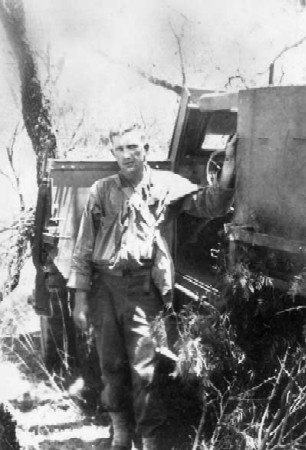
This album page shows various scenes from Camp Barkeley, Texas. Camp Barkeley was decommissioned in 1946 and no longer exists, and its location is now marked by a Texas State Historical marker. From James M. Myers, The Handbook of Texas is this description of the Camp:
"CAMP BARKELEY. Camp Barkeley was eleven miles southwest of Abilene in Taylor County. It was originally planned as a temporary camp for infantry and supply troops, but during World War II it became one of the state's largest military installations. The camp was named for David B. Barkley, a native Texan who was awarded the Medal of Honor in World War I. A clerical error apparently caused the discrepancy in spelling. Construction of the camp began in December 1940. The government leased 70,229 acres, with the option to purchase a small portion, to accommodate the facility and maneuvering grounds. Although the cost of the camp was originally estimated at $4 million, when it was completed in July 1941 costs totaled $7 million.
The first unit to occupy the camp was the Forty-fifth Infantry Division, consisting of 19,000 men under the command of Maj. Gen. William S. Key. The division occupied the still unfinished camp on February 23, 1941. The 45th Divisional News was published at Camp Barkeley. One member of the paper's staff, William Mauldin, became a famous war cartoonist during World War II. Other units in addition to the Forty-fifth trained at Camp Barkeley, among them the Ninetieth Infantry Division and the Eleventh and Twelfth Armored divisions. A medical officer candidate school was established at Barkeley in May 1942, and from it 12,500 candidates eventually graduated.
The camp also served as a camp for German prisoners of war. On February 1, 1944, the 1846th Unit POW Camp was activated under the command of Lt. Col. Harry Slaughter. At its peak in March 1945 the POW camp housed 840 prisoners. Two months after the camp opened, twelve prisoners escaped, but all were recaptured within a week.
On April 30, 1945, Camp Barkeley was deactivated. At its peak it had a total population of 50,000. It was officially closed in September 1945 and dismantled. The War Department estimated the total cost from December 1940 to September 1945, including land and construction, at $27,332,000. At the time it closed, the military reservation encompassed one-ninth of Taylor County-77,436 acres-of which the government owned 18,976. After the camp was abandoned, the leased land reverted to its owners. Camp Barkeley had long-term effects on Abilene. Construction and army payrolls helped the local economy, and the community's demonstrated ability to maintain satisfactory relations with a large military population was a factor in the government's decision in the 1950s to locate Dyess Air Force Baseqv there.
BIBLIOGRAPHY: John J. Hatcher, "Camp Barkeley: Abilene, Texas," Texas Military History 3 (Winter 1963). James M. Myers, World War II as an Instrument of Social Modernization: The Social and Economic Influence of Camp Barkeley on Abilene, Texas (M.A. thesis, Hardin-Simmons University, 1981)."
James M. Myers, The Handbook of Texas

This photograph shows Bill Otto standing next to a half track in Camp Bowie. He's wearing a gas mask strapped at his side. He was later sergeant, I think in 1944, for another squad, and then he returned to our squad at the end of the war.
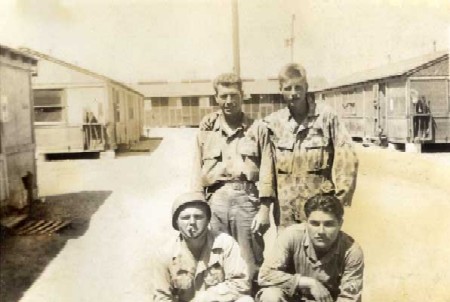
This photograph shows members of my platoon. Upper left is Marion Best, who lost both his legs at Herrlischiem. Lower left, Henry Gentry, with a cigar, part of the machine gun squad and blown of a tank by a shell and wounded, I think at the same time, with Best, Otto, Alendoerfer, Molan and Copus at the initial battle at Herrleshiem. At lower right is Phil Colunga, our half track driver. I was co-driver. On the barracks behind are the paintings that Ed Strazdes ("Graffitti Ed") painted representing each squad (they appear as small white squares), and can be seen closer on page 13. I think he used his own hair to make paint brushes.
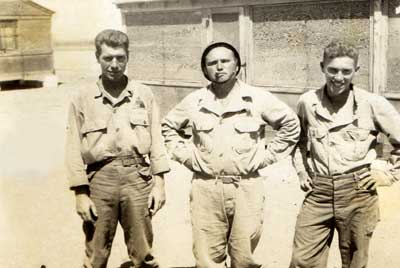
This shows Marion Best, Henry Gentry, and John Tedrowe. John now lives in Stone Mountain, Georgia. He became squad sergeant at the end of the war. He was wounded at the end of the war and I never saw him again.
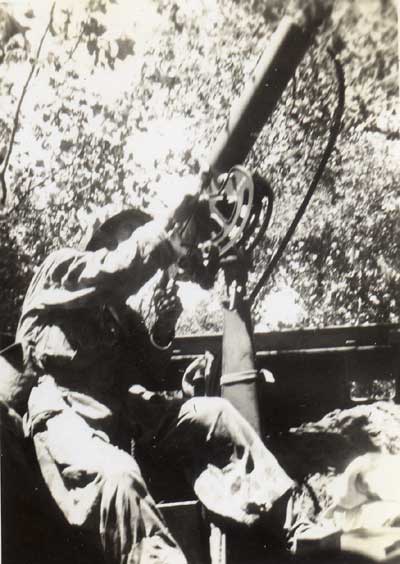
This photograph shows me manning the half track's water cooled 30 ca. machine gun during a training exercise. The machine gun was for anti-aircraft, and the half tracks were often equipped with 50 ca. machine guns that fired five rounds. The five rounds were two incendiary, two armor piercing, and a tracer bullet.
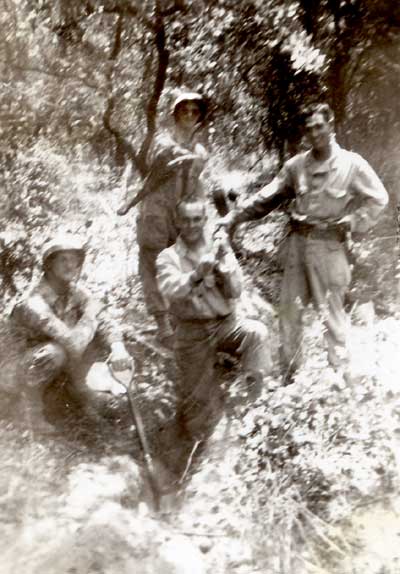
This photograph shows a rifle squad at latrine duty. Al Schaefer is standing in the ditch and was my best friend during the war. He was killed at Herrlishiem.
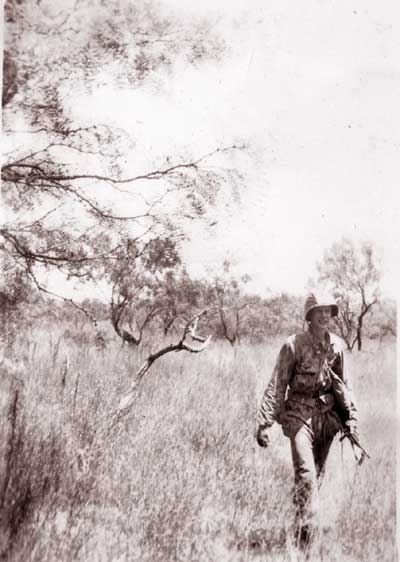
This is me returning from a maneuver outpost. I'm wearing a camouflage uniform, which I liked but it was later confiscated . I'm carrying an M1 carbine, which weighed five pounds less than the M1 rifle, and fired a 30 ca. round.
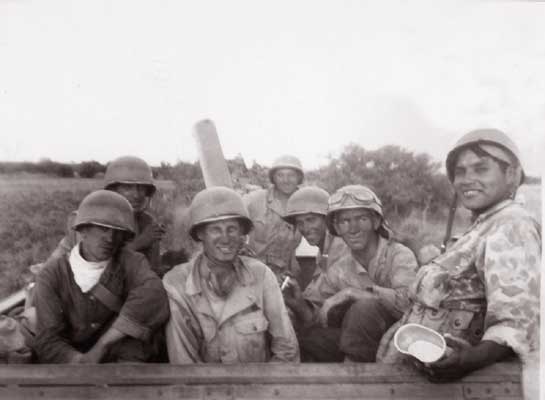
This photograph shows my mortar squad in our half track. Phil Colunga is carrying an aluminum canteen cup that burned your mouth when it had coffee in it. There was a small gas stove mounted on the fender of the half track for making coffee. Were sitting in the turret of the half track. Phil Coulunga is now wearing the camouflage, I'm not, maybe we switched uniforms. He's also wearing an ammo belt for a rifle, although as the driver he was only equipped with a "grease" gun. At Herrlisheim, Phil and I stayed back with the half Track, I was supposed to man the gun. In a mortar squad, there were only 8 members, not 12 like in a rifle squad. Everyone, except Phil and I, were killed or wounded in the first wave. I remember asking when guys were coming back wounded from the battle, "how 's the mortar squad?" and the answer was, "they all got it", this really shook me up.
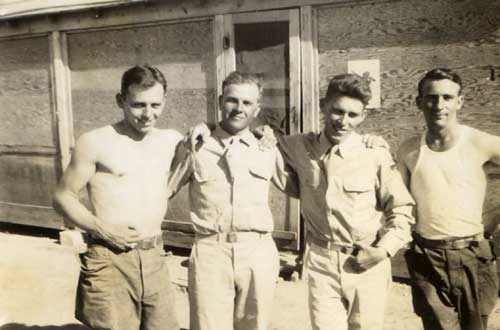
This photograph shows members of my mortar squad. "Graffitt Ed"'s painting can be seen behind on our barracks. All but John Tedrowe had been in the Civilian Conservation Corp during the Depression, and so had previous army-like experience. All of these men were wounded on January 8th, 1944 at Herrlishiem. Copus and Mullan were seriously wounded and did not return to the squad after being wounded.